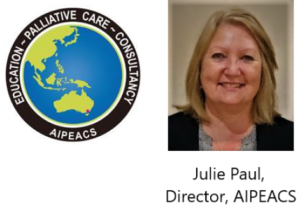
- 今月は、終末期患者が希望する場合、自宅で最期を迎えることを支える上で家庭医が果たす重要な役割について考えてみたいと思います。
-
オーストラリアでは、患者が自宅で亡くなりたいという願いを叶えるために、家庭医の役割が極めて重要であると言われています。 患者と家族のニーズを積極的に把握することが重要であり、医療チームと連携する家庭医の役割は極めて大きいと認識しています。
-
家庭医が患者・家族と共に行う「計画的な在宅死の支援:家庭医のためのチェックリスト」という非常に有用な資料を見つけました。
このチェックリストをぜひご覧いただき、日本の視点からも有用なリソースとなり得るかご検討ください。 このチェックリストは、専門的な緩和ケアチームが関与しない場合において、在宅で亡くなる患者へのケアの主要な側面が話し合われ、文書化されるよう、かかりつけ医と医療チームを支援するものと考えます。
https://www.caresearch.com.au/Portals/20/Documents/Health-Professionals/GPChecklistForAHomeDeath.pdf
-
このツールに含まれる項目がカバーされない場合、患者の在宅ケア継続が困難になる可能性が高いことは明らかです。ツールがカバーする領域は以下の通りです:
- 1.期待と支援の明確化:
-
-
- ・患者は自宅で死を迎えることを希望していると認識しているか?
- ・家族は患者の自宅での死への希望を共有しているか?
- ・ケアを分担する十分な人数は確保されているか?
- ・予後を確認し、家族が事前に計画を立てられるように支援する(ケアが必要となる期間は数日、数週間、数ヶ月か?)
- ・患者または家族が在宅ケアの継続が困難になった場合の代替計画があるか確認する
- 2.自宅環境の評価:
- ・患者が自宅で安全かつ快適にケアを受けられるか?
- 3.症状管理計画の立案
- ・患者の快適性に寄与しなくなった薬剤の見直しと中止の検討
- ・症状の評価・管理方法について患者・家族と協議する
- ・終末期に予想される症状への対応を介護者に計画・準備させる
- ・自宅に緊急時用薬剤が常備されていることを確認する
- ・大出血リスクなどハイリスクな問題の有無を確認し、予防的計画を策定する
- 4.家族が必要とする情報
- ・介護者が十分に準備できているか
- ・患者が死を迎える過程で生じる身体的変化についての介護者向け教育
- ・家族が24時間サポートを受けられるようにする
- ・患者が亡くなった際の対応について家族への説明
- 要な点として、このツールには上記の見出しごとに確認項目が設けられており、必要な情報を確実に網羅できるように設計されています。回答と計画はフォームに記録され、特定された対応策も記載されます。この情報は医療チーム全員で共有可能です。
- このチェックリストについて、皆様のご意見をお聞かせください。臨床実践の向上、患者・家族とのコミュニケーション改善、そして希望される場合には在宅での終末期ケア実現に役立つ新たな知見を得られたかどうか、ぜひお聞かせください。
- この分野の追加リソースにご興味があれば、いつでもお知らせください。お送りいたします。緩和ケアに関する皆様のご意見や経験を共有し、互いに学び合える場を大切にしておりますので、ご状況をお聞かせください。
お気をつけて。 ジュリー
ジュリー・ポール – OAM
-
-
Disclaimer: August 2025 免責条項:
Julie’s Update シリーズ内の内容につき正確な情報の提供に細心の注意を注いでいますが、特にある事柄についての専門的意見を提供するものではありません。このシリーズに含まれる情報は、独立した専門家の見解に取って代るものではありません。また、医療上の助言として利用したり、何らかの疾患の治療、手当、又は、予防のために使用されるものではありません。
このシリーズにより提供される情報の利用、依存によるいかなる法的責任、怪我、紛失、損害については、責任は負いません 。
-
Julie’s Update: August2025(原文)
JULIE’S UPDATE: August 2025
This month I would like us to think about the important role of the family Doctor in supporting terminal patients to have a home death, if that is their preference.
In Australia we say the family Doctors role is crucial to enable patients to fulfil their wish of dying at home. We know it is important to identify patient and family’s needs in a proactive way and together with the health care team the family Doctor has a critical role.
I came across a very useful check list for family Doctors to complete with patients and families, titled: Supporting a planned home death: The GP’s Checklist.
I encourage you to read the checklist and consider whether you think it would be a valuable resource from a Japanese perspective. I believe the check list would assist the family doctor and the health care team to ensure the main aspects of care for patients dying at home are discussed and documented, where a specialised palliative care team is not involved in the patients care.
https://www.caresearch.com.au/Portals/20/Documents/Health-Professionals/GPChecklistForAHomeDeath.pdf
What we do know is that if the aspects within the tool are not covered, then it is likely to lead to difficulties in enabling the patient to stay at home. The tool covers areas such as:
- 1.Clarifying expectations and support:
- ・Has the patient identified they want to die at home?
- ・Do the family share the patient’s preference for a home death?
- ・Are there enough people to share the care?
- ・Review the prognosis to help the family plan ahead (is the care likely to be needed for days, weeks or months?)
- ・Confirming is there a backup plan, if either the patient or family find it difficult to continue the care at home?
- 2.Assess the home situation:
- ・Can the patient be cared for safely and comfortably in their home?
- 3.Plan for symptom management
- ・Review and consider ceasing medications that are no longer contributing to the patient’s comfort
- ・Discussions with the patient and family as to how symptoms will be reviewed and managed
- ・Planning and preparing carers for symptoms we expect at end of life
- ・Ensuring emergency medications are available in the home
- ・Are there any high risk problems for example risk of major bleeding and putting a proactive plan in place?
- 4.Information that families need
- ・Are carers fully prepared
- ・Education for carers about physical changes that occur as the patient is dying
- ・Ensure family have access to 24-hour support
- ・Education for families about what to do when the patient dies
- Importantly the tool has prompts under each of the headings above to ensure we are consistently covering all of the information required. Answers and plans are documented on the form. Identified actions are also noted and the information is available to all of the health care team members.
- I am very interested in your thoughts on this check list. Whether there was any new information you learnt you can use to enhance your clinical practice, improve communication with patients and families, and ensure patients are more likely to die at home, if that is their preference.
- As always, if you are interested in more resources in this area, please let me know and I can forward them through to you. Please let me know how you are going, as we enjoy sharing your thoughts and experiences on palliative care, so we can continue to learn from each other
Stay safe and take care. Julie
Julie Paul – OAM
